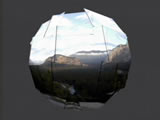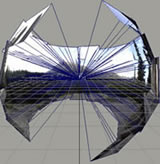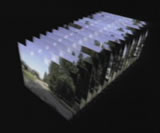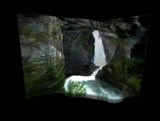|
Study #1 - Panoramic and Moviemap
Studies in Computer 3-Space These studies were produced in the
two weeks. Simple tools were used in the field, including various
maps, compass, level, optical rangefinder, tripod, car mount, and
a portable video camera.
First, a landscape was recorded on video by panning the camera,
moving the camera forward, and moving the camera sideways. Next,
still frames were selected by hand to composite a complete panorama
or a moviemap. Then wireframe models were made, based on the parameters
of the camera lens and movements. Finally, the video still frames
were texture mapped into the wire frame.
Study #2 – Virtual Relief Projection for "Placeholder"
Study #2 was an attempt to map camera-based images onto hand-shaped
surfaces in computer 3-space. Like Study #1, the goal was to use
field-recorded imagery to make 3D computer models. The imagery was
used as the basis for "roughing out" the appropriate shape
of the wireframe on which to texture map it. These "virtual
relief projections" were used as the basis for one of the worlds
in the Placeholder project, by Brenda Laurel and Rachel Strickland.
Study #1:
Siggraph Guerrilla Technology Show, Chicago, 1992
Study #2:
"Placeholder," Banff Centre for the Arts, 1993
Credits
Supported by the Art and Virtual Environments Program
Banff Centre for the Arts, Canada
Study #1:
Concept and Direction: Michael Naimark
Principal Software Collaborator: John Harrision
Banff Centre: Douglas MacLeod, Cathy McGinnis, Gilles Tassé,
Luke Van Dyk, Maureen Lee, Kerry Stauffer
Thank You: Loren Carpenter, Richard Hollander, Henry Holtzman
Study #2:
Concept and Direction: Michael Naimark
Principal Collaborators: Brenda Laurel and Rachel Strickland
Principal Software Collaborator: John Harrision
For complete Placeholder credits, see:
|



